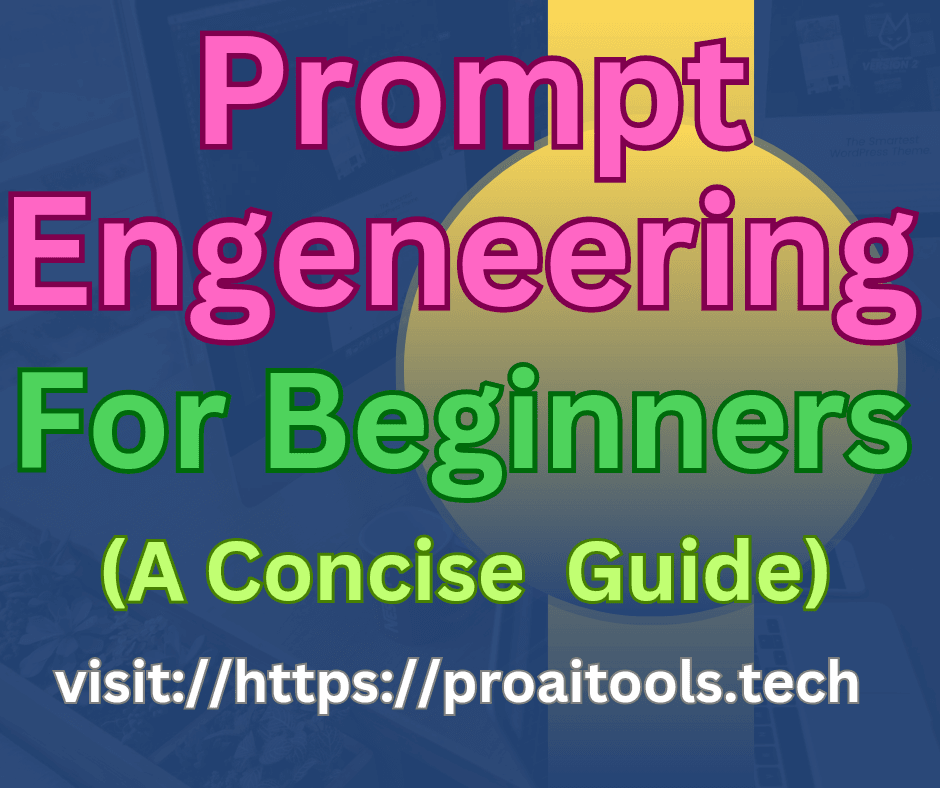Prompt Engineering for Beginners: Concise Course
Writing prompts for AI might sound simple, but it’s the key to unlocking their full potential. Prompt engineering is all about asking questions or setting instructions in a way that an AI model can understand and respond effectively. For beginners, this skill can open doors to creating better chatbots, streamlining workflows, or even tackling creative projects with AI. In this course, you’ll gain a clear understanding of how to communicate with AI models—no prior coding skills needed.
Understanding the Basics of Prompt Engineering
In the world of AI, the way we communicate with models determines their responses and usefulness. Prompt engineering plays a central role in ensuring meaningful interactions between humans and AI. Let’s break it down to understand what prompts are and why crafting them effectively matters.
What is a Prompt?
A prompt is a message or question you give to an AI to get a response. It’s like asking a friend for advice—you phrase your question based on what you want to know. For AI, prompts are formulated instructions or input that guide the system’s output. They can be a sentence, a question, or even a structured template.
For example, asking “What are the benefits of renewable energy?” will guide the AI to provide an informative response, while a vague prompt like “Tell me stuff” may result in less useful answers.
Think of a prompt as a key. When you use the right key (well-constructed prompt), it unlocks the relevant information stored in the AI model. Prompts also work in:
- Generating creative content like stories or art.
- Answering technical or product-related queries.
- Automating repetitive tasks with clearer instructions.
The power of a good prompt lies in its clarity. Giving detailed, context-specific instructions greatly improves the AI’s accuracy. If you’re curious, here’s more about what an AI prompt is and how it works.

Photo by Sanket Mishra
Importance of Prompt Engineering
Why should you care about crafting effective prompts? Because it’s the backbone of successful AI applications. A poorly written prompt can lead to irrelevant or even misleading outputs, while a thoughtful one can produce solutions that align with your goals.
Here’s why prompt engineering is essential:
- Accuracy: A precise prompt provides targeted and reliable responses. This helps minimize errors in tasks like reporting or data analysis.
- Efficiency: By reducing back-and-forth questions to clarify input, you save time and streamline interactions with AI.
- Contextual Relevance: A structured and descriptive prompt ensures that AI understands the intent behind your input, leading to consistent results.
- Scalability: For developers, prompt engineering is fundamental when working with large-scale applications like virtual assistants or customer support tools.
Effective prompt crafting ensures AI doesn’t just give acceptable answers but delivers insightful outputs closely tied to user demands. It’s the difference between having a conversation with an expert versus receiving generic advice.
Want to dig deeper? See this detailed guide on the importance of prompt engineering for AI communication.
This skill is becoming invaluable as more industries depend on AI for tailored solutions. With a little practice, anyone can master it—and unlock the full potential of AI tools.
Core Concepts of Prompt Engineering
Prompt engineering is the key to unlocking precise and meaningful responses from AI systems. By crafting clear instructions or queries, you can effectively communicate your objectives and extract valuable outputs. This section explores the types of prompts, strategies to design them effectively, and common pitfalls to avoid for beginners eager to master prompt engineering.
Types of Prompts
Prompts can generally be divided into three main categories: open-ended, closed, and task-specific. Understanding these types helps you match the right prompt to your goal.
- Open-Ended Prompts:
These prompts aim for broad answers, encouraging creativity or exploration. For example:- “What does the future of AI look like?”
Open-ended prompts are great for brainstorming and idea generation but might yield less precise results if too vague.
- “What does the future of AI look like?”
- Closed Prompts:
These are focused and direct, often requiring a specific answer.- Example: “What is the capital of France?”
Closed prompts help maintain control over the AI’s response, ensuring concise outputs.
- Example: “What is the capital of France?”
- Task-Specific Prompts:
As the name suggests, these are tailored to perform particular tasks. They often include explicit information about the operation or format needed.- Example: “Write an email introducing a new software update.”
Task-specific prompts are the backbone of productivity-related AI use cases.
- Example: “Write an email introducing a new software update.”
Each prompt category unlocks unique possibilities. For more on this, see 8 Types of Prompt Engineering.
Strategies for Effective Prompt Design
Crafting the perfect prompt often requires trial and error, but a few proven strategies can streamline the process. Keep these actionable tips in mind:
- Be Specific:
Vague language leads to vague results. Focus on what you need, and reduce unnecessary ambiguity.- Example: Instead of “Summarize this,” try “Summarize the key benefits mentioned in this article.”
- Use Context:
Providing relevant background helps AI understand your request better. Contextual details shape more accurate outputs. - Incorporate Examples:
Show examples of desired responses to guide the AI model. Clear illustrations set the standard for the reply’s tone, style, or format. - Assign a Role:
Assigning AI a role narrows its focus. For instance, you might say, “Act as a customer service agent and answer this question.” - Iterate and Refine:
Prompt design isn’t a one-and-done process. Learn from the AI’s outputs and improve the wording repeatedly.
For more advanced design strategies, check out Prompt Design Tips.
Common Mistakes in Prompt Engineering
Beginners often stumble upon predictable errors when starting with prompt design. Here are the most common mistakes and ways to sidestep them:
- Being Too Vague:
Open-ended prompts without clear direction often lead to irrelevant or unhelpful responses. Always add context and specifics. - Overloading Information:
Excessively long or complex prompts can confuse AI, diluting the result. Stick to concise and clear instructions. - Ignoring Feedback:
Many users fail to iterate on their prompts. If the output doesn’t align with expectations, tweak and retry. - Misjudging AI Capability:
Not all AI models are capable of handling highly abstract or intricate tasks. Acknowledge the system’s limitations for realistic outputs.
Avoiding these traps can save time and prevent frustration. Learn more from articles such as Common Mistakes in Prompt Engineering.
By understanding prompt types, embracing strategic design approaches, and avoiding simple errors, prompt engineering becomes an indispensable skill for anyone working with AI systems.
Practical Applications of Prompt Engineering
Prompt engineering is more than just structuring phrases; it drives how AI systems interact with real-world problems. By tailoring inputs, we allow AI to serve specific industries and tasks. Here, we’ll explore its impactful applications, from chatbots to content creation and data analysis.
Using Prompts in Chatbots
Chatbots rely heavily on efficient prompts to understand user queries and provide meaningful responses. With prompt engineering, bot creators can guide AI behavior to meet user expectations.
How does it help? Think of prompts like scripts for actors. If the script is clear, the actor delivers better. Similarly, precise prompts enhance the chatbot’s ability to interact naturally and handle diverse scenarios.
- Customer Support: Chatbots can manage FAQs or troubleshoot customer issues when guided with problem-specific prompts.
- Personalization: By embedding user preferences, prompts can create tailored experiences, like suggesting products or services customers are likely to buy.
- Functionality Expansion: Chatbots can perform tasks beyond text responses, such as booking appointments or issuing refunds—thanks to well-crafted prompts.
For tips on writing effective chatbot prompts, check out How to Write Killer ChatGPT Prompts for Your Chatbot.
Prompt Engineering in Content Generation
Creating publish-ready content manually can be tedious. AI-powered content generators can change that—if used correctly. By engineering targeted prompts, users can automate tasks like blog writing, ad generation, or even video scripts.
Key transformations brought by prompts in content creation:
- Style Customization: Use prompts to mimic specific tones, such as formal, conversational, or humorous styles. An input like, “Write a blog post intro in an engaging, friendly tone,” radically shifts the outcome.
- Automating Repetitive Tasks: Examples include generating email copy from templates or drafting event announcements within minutes.
- Consistency Across Platforms: With pre-structured prompts, you ensure uniformity in branding, voice, and messaging.
Want to dive deeper? Visit Prompt Engineering for Content Creation for structured steps and more examples.
Applications in Data Analysis
Data analysis deals with slicing through big data to find actionable insights. Prompt engineering brings AI into the mix, helping analysts explore patterns, trends, and anomalies faster.
Here’s how it works:
- Query Formulation: Data analysis tools read prompts to translate user intent into actionable queries. For instance, “Summarize top sales regions for Q3 using this dataset” directs AI to process data accurately.
- Model Automation: Prompts enable automating predictive models, saving both time and technical expertise.
- Pattern Recognition: AI can identify trends across complex data sets or generate visualizations on demand through refined prompt inputs.
Explore more on this topic through Applications of Data Analytics.

Photo by Sanket Mishra
By utilizing these techniques, industries are leveraging AI’s computational power to transform how tasks are executed. Prompt engineering, at its core, is the bridge connecting raw AI capabilities with tangible outcomes.
Getting Started with a Prompt Engineering Course
Embarking on your journey into prompt engineering begins with selecting the right course. Whether free or paid, countless platforms offer educational resources tailored to beginners. But how do you choose the one that matches your learning goals? Let’s explore the options available and what features to prioritize in a course.
Free and Paid Course Options
There are plenty of free and paid resources online that cater to beginners in prompt engineering. Whether you’re looking to dip your toes in the water or dive into an in-depth program, here are some of the best platforms to consider:
- Coursera: A platform known for its high-quality, affordable courses. Check out their prompt engineering courses. These often include certificates and job-ready projects.
- LearnPrompting.org: They offer free resources and practical guidance, such as their list of top online courses catering to all levels, from beginner to advanced.
- Medium Articles: Resources like 10 Free Prompt Engineering Resources break down courses and tools available at no cost.
- Udemy: This platform features comprehensive, practitioner-focused paid options. Browse Udemy’s top prompt engineering courses for details on specific learning paths.
Free resources are ideal for those exploring casually, while paid programs often deliver deeper, structured content that caters to targeted skill-building and certifications.
Key Features to Look for in a Course
Choosing the right prompt engineering course depends on its ability to meet your learning style and goals. Here are the essential features to ensure the course delivers maximum value:
- Practical Hands-On Exercises
Courses should include real-world assignments where you can practice writing prompts, testing them, and analyzing outputs. This bridges the gap between theory and actionable skills. - Comprehensive Content
A great course dives beyond surface-level concepts. Look for modules covering:- Basic prompt crafting techniques.
- Advanced troubleshooting and debugging prompts.
- Applications across industries like content creation or data analytics.
- Updated Curriculum
AI evolves quickly. A good course stays current with the latest models like GPT-4 or MidJourney advancements. This ensures skills you acquire remain relevant. - Expert-Led Instruction
Instructors should have expertise in generative AI tools or significant industry experience. Evaluate their credentials through course previews or reviews. - Community Support
Active forums or discussions elevate learning. Being part of a learner community allows you to exchange ideas, troubleshoot issues, and expand your knowledge collaboratively. - Certifications and Career Value
Paid programs with certification options, such as Coursera’s professional certificates, boost resumes and validate your skills to potential employers.
If you’re considering paid certifications, check resources like the top certifications for prompt engineering for insights.
By focusing on these elements, you’ll ensure your selected course aligns with your career aspirations and provides a solid foundation in prompt engineering.
Tools and Resources for Prompt Engineers
When diving into prompt engineering, having the right tools and support makes all the difference. Whether you’re experimenting with new prompts or expanding your skills, leveraging the right resources can significantly improve your workflow and learning. Let’s explore the most popular tools for prompt testing and where to find a thriving community for ongoing support.
Popular Tools for Prompt Testing and Evaluation
The effectiveness of a prompt often depends on robust testing and refinement. Fortunately, there are several tools available to streamline this process. These tools give you insights into how prompts perform and areas where they can be optimized.

Photo by Pixabay
Here are some popular ones to consider:
- OpenAI Playground
This interactive platform lets you test prompts directly with OpenAI models like GPT-4. It provides options to tweak parameters and view instant outputs to refine your results. - PromptLayer
A tool specifically designed to help manage and log prompt interactions. With features like version control and analytics, it’s a must-have for serious prompt engineers. Learn more about PromptLayer in this review of top tools. - LangSmith by LangChain
A versatile tool for testing language model prompts enhanced with traceability and visualization options. It’s particularly useful for debugging complex workflows. - HegeltAI PromptTools
Open-source and self-hostable, HegeltAI provides a suite of solutions for testing and improving your prompts. Find their toolset on GitHub. - Azure PromptFlow
A robust tool for professionals working with Microsoft’s Azure services. It simplifies testing large-scale platforms and fine-tuning nuanced prompts.
For those just starting, consider checking out more detailed guidance on these tools and their usage in this comprehensive post.
Community and Support Resources
Beyond tools, having a supportive community can dramatically improve your journey as a prompt engineer. Communities offer a space to share tips, resolve issues, and collaborate on creative ideas.
Here are some top resources to join:
- r/PromptEngineering (Reddit)
A productive and active place for users to post questions, share tips, and discuss prompt-related challenges. Join the community here. - PromptStacks
A free community hub for discussing AI prompts, sharing strategies, and even learning new tricks. Connect with peers on PromptStacks’ website. - Learn Prompting
This is more than a community—it’s also an educational platform perfect for beginners. Explore their forums and guides on advanced prompting techniques via The Hive Index. - AIPRM Community Forum
A user-led forum tailored for solving issues and evolving new ideas in AI prompting. Start exploring it here. - Meetup.com Prompt Engineering Groups
If in-person or online events appeal to you, check out Meetup for workshops and collaborations in the field. Visit Meetup Groups for upcoming events.
With these resources at your fingertips, you’ll find the support and collaboration needed to grow your skills systematically.
Conclusion
Mastering prompt engineering is an investment in your personal and professional growth. It equips you with the tools to harness AI’s potential effectively, regardless of your technical background. From improving interactive communication to automating tasks and creating dynamic solutions, the skills you build here translate into real-world impact.
Dive into a beginner-tailored course today and start practicing with hands-on exercises and testing tools. This is your invitation to not just understand AI but to shape its outputs and drive innovation in everyday applications. Ready to start creating smarter prompts? Take control of your learning and see how far this skill can take you.
We have created a course of prompt Engineering. This course is for beginners only . The course is divided in 8 parts in form of articles. Following are the links of all other parts of the course :
Click here for Prompt Engineering (Beginners) Part- 1
Click here for Prompt Engineering (Beginners) Part- 2
Click here for Prompt Engineering (Beginners) Part- 3
Click here for Prompt Engineering (Beginners) Part- 4
Click here for Prompt Engineering (Beginners) Part- 5
Click here for Prompt Engineering (Beginners) Part- 6
Click here for Prompt Engineering (Beginners) Part- 7
Click here for Prompt Engineering (Beginners) Part- 8
Very soon we’ll introduce intermediate level and advanced level of prompt engineering .


